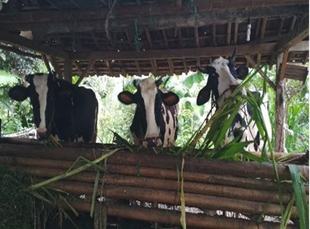Addition of dextrose and caffeine to the intravenous treatment of milk fever in Holstein Friesian cattle

Downloads
A farmer reported a cow unable to stand 48 hours postpartum. The cow was a 2.5 years old dairy cow with a body weight of around 350 kg. The cow was fed elephant grass, standard concentrate (16–18%) crude protein, and drinking water ad libitum without mineral supplementation during the dry season. The cow's position and posture when lying down, ear temperature, and eye pupils were included in the physical examination. Availability of food and drink was examined to predict appetite and thirst. The results of the history and physical examination showed that the cow was unable to stand 48 hours after calving, had no appetite and eye reflexes, had cold ears, and trembling hind legs. The cow was laid on its right side, with its head turned to flank. Based on the anamnesis and physical examination, the cow was diagnosed as suffering from stage 2 puerperal hypocalcemia. The cow was infused via the jugular vein with a solution containing 270 mg calcium borogluconate, 70 mg magnesium borogluconate, 300 mg dextrose, 5 mg phosphorus element, 2 mg potassium chloride, and 5 mg caffeine per 1 mL of solution. Forty-five minutes after the infusion, the cow was able to stand, although it still looked weak. It could be concluded that the addition of dextrose and caffeine to the standard treatment of milk fever was beneficial for recovery.
Allgrove J. 2015. Physiology of calcium, phosphate, magnesium, and vitamin D. Endocr Dev. 28: 7-32.
Arechiga-Flores CF, Cortés-Vidauri Z, Hernández-Briano P, Lozano-Domínguez RR, López-Carlos MA, Macías-Cruz U, Avendaño-Reyes L. 2022. Hypocalcemia in the dairy cow. Review. Rev Mex Cienc Pecu. 13: 1025-54.
Argilés JM, Campos N, Lopez-Pedrosa JM, Rueda R, Rodriguez-Mañas L. 2016. Skeletal muscle regulates metabolism via interorgan crosstalk: Roles in health and disease. J Am Med Dir Assoc. 17: 789-96.
Aubineau T, Guatteo R, Boudon A. 2022. Implementation of hypocalcemia prevention programs in commercial dairy herds: From theory to practice. Animal 16: 100639.
Bikle DD. 2021. Vitamin D: Production, metabolism, and mechanisms of action. [Updated 2021 Dec 31]. In: Feingold KR, Anawalt B, Blackman MR, et al. (Eds). Endotext [Internet]. MDText.com, Inc. South Dartmouth (MA), US.
Braga Paiano R, Becker Birgel D, Harry Birgel Junior E. 2019. Uterine Involution and Reproductive Performance in Dairy Cows with Metabolic Diseases. Animals (Basel) 9: 93.
Braun U, Blatter M, Büchi R, Hässig M. 2012. Treatment of cows with milk fever using intravenous and oral calcium and phosphorus.Schweiz Arch Tierheilkd. 154: 381-8.
Chiba Y, Nozaki I, Itoh M, Kawamoto S. 2023. Noninvasive measurement of blood calcium concentration using electrocardiography in peripartum Jersey cows. Front Vet Sci. 10: 1198367.
Chiwome B, Kandiwa E, Mushonga B, Sajeni S, Habarugira G. 2017. A study of the incidence of milk fever in Jersey and Holstein cows at a dairy farm in Beatrice, Zimbabwe. J S Afr Vet Assoc. 88: e1-e6.
DeGaris PJ, Lean IJ. 2008. Milk fever in dairy cows: a review of pathophysiology and control principles. Vet J. 176: 58-69.
Dunn J, Grider MH. 2023. Physiology, adenosine triphosphate. [Updated 2023 Feb 13]. In: StatPearls [Internet]. StatPearls Publishing. Treasure Island (FL), US.
Eder K, Grundmann SM. 2022. Vitamin D in dairy cows: metabolism, status, and functions in the immune system. Arch Anim Nutr. 76: 1-33.
Evans PL, McMillin SL, Weyrauch LA, Witczak CA. 2019. Regulation of skeletal muscle glucose transport and glucose metabolism by exercise training. Nutrients 11: 2432.
Ferreira LHB, Forbes SC, Barros MP, Smolarek AC, Enes A, Lancha-Junior AH, Martins GL, Souza-Junior TP. 2022. High doses of caffeine increase muscle strength and calcium release in the plasma of recreationally trained men. Nutrients 14: 4921.
Fleet JC. 2017. The role of vitamin D in the endocrinology controlling calcium homeostasis. Mol Cell Endocrinol. 453: 36-45.
Hodnik JJ, Ježek J, StariÄ J. 2020. A review of vitamin D and its importance to the health of dairy cattle. J Dairy Res. 87: 84-87.
Khaziev E, Samigullin D, Zhilyakov N, Fatikhov N, Bukharaeva E, Verkhratsky A, Nikolsky E. 2016. Acetylcholine-induced inhibition of presynaptic calcium signals and transmitter release in the frog neuromuscular junction. Front Physiol. 7: 621.
Kocabagli N. 2018. Prevention of milk fever: A herd health approach to dairy cow nutrition. Arch Anim Husb Dairy Sci. 1: 1-3.
Libera K, Konieczny K, Witkowska K, Żurek K, Szumacher-Strabel M, Cieslak A, Smulski S. 2021. The association between selected dietary minerals and mastitis in dairy cows-A review. Animals (Basel) 11: 2330.
Mahen PJ, Williams HJ, Smith RF, Grove-White D. 2018. Effect of blood ionized calcium concentration at calving on fertility outcomes in dairy cattle. Vet Rec. 183: 263.
McArt JAA, Divers TJ, Peek SF. 2018. Metabolic diseases: Milk fever. In: Peek SF, Divers TJ (Eds). Rebhun's Diseases of Dairy Cattle. 3rd Ed. Elsevier B.V. Amsterdam. 713-36.
McGrath J, Duval SM, Tamassia LFM, Kindermann M, Stemmler RT, de Gouvea VN, Acedo TS, Immig I, Williams SN, Celi P. 2017. Nutritional strategies in ruminants: A lifetime approach. Res Vet Sci. 116: 28-39.
Melendez P, Chelikani PK. 2022. Review: Dietary cation-anion difference to prevent hypocalcemia with emphasis on over-acidification in prepartum dairy cows. Animal 16: 100645.
Melendez P, Poock S. 2017. A dairy herd case investigation with very low dietary cation-anion difference in prepartum dairy cows. Front Nutr. 4: 26.
Mesquita RNO, Cronin NJ, Kyröläinen H, Hintikka J, Avela J. 2020. Effects of caffeine on neuromuscular function in a non-fatigued state and during fatiguing exercise. Exp Physiol. 105: 690-706.
Mills KE, Weary DM, von Keyserlingk MAG. 2019. Identifying barriers to successful dairy cow transition management. J Dairy Sci. 103: 1749-1758.
Pacheco HA, da Silva S, Sigdel A, Mak CK, Galví£o KN, Texeira RA, Dias LT, Peñagaricano F. 2018. Gene mapping and gene-set analysis for milk fever incidence in Holstein dairy cattle. Front Genet. 9: 465.
Peek SF, Buczinski S. 2018. Cardiovascular diseases. In: Peek SF, Divers TJ (Eds). Rebhun's diseases of dairy cattle. 3th Ed. Elsevier, Missouri, US. 46-93.
Perween S, Singh A, Gupta M, Sahoo JK. 2018. An update on milk fever and its economic consequences. Int J Curr Microbiol App Sci. 7: 2735-42.
Probo M, Pascottini OB, LeBlanc S, Opsomer G, Hostens M. 2018. Association between metabolic diseases and the culling risk of high-yielding dairy cows in a transition management facility using survival and decision tree analysis. J Dairy Sci. 101: 9419-29.
Redfern EA, Sinclair LA, Robinson PA. 2021. Why isn't the transition period getting the attention it deserves? Farm advisors' opinions and experiences of managing dairy cow health in the transition period. Prev Vet Med. 194: 105424.
Rodríguez EM, Arís A, Bach A. 2017. Associations between subclinical hypocalcemia and postparturient diseases in dairy cows. J Dairy Sci. 100: 7427-34.
Saborío-Montero A, Vargas-Leitón B, Romero-Zúñiga JJ, Sánchez JM. 2017. Risk factors associated with milk fever occurrence in grazing dairy cattle. J Dairy Sci. 100: 9715-22.
Schafer AL, Shoback DM. 2016. Hypocalcemia: Diagnosis and treatment. [Updated 2016 Jan 3]. In: Feingold KR, Anawalt B, Blackman MR, et al. (Eds). Endotext [Internet]. MDText.com, Inc. South Dartmouth (MA), US.
Sudrajat A, Amin L, Sambodo R, Christi RF, Ismail F. 2022. Potensi kerugian ekonomi yang diakibatkan oleh penyakit milk fever pada sapi perah. Prosiding Seminar Nasional Agribisnis, Fakultas Pertanian Universitas Khairun 2: 196-8.
Tadesse E, Belete L. 2015. An overview on milk fever in dairy cattle in and around west Shoa. World J Biol Medical Sci. 2: 115-25.
Takada S, Fumoto Y, Kinugawa S. 2022. Ergogenic effects of caffeine are mediated by myokines. Front Sports Act Living. 4: 969623.
Tsuda S, Egawa T, Kitani K, Oshima R, Ma X, Hayashi T. 2015. Caffeine and contraction synergistically stimulate 5'-AMP-activated protein kinase and insulin-independent glucose transport in rat skeletal muscle. Physiol Rep. 3: e12592.
Tsuda S, Hayashi T, Egawa T. 2019. The Effects of caffeine on metabolomic responses to muscle contraction in rat skeletal muscle. Nutrients 11: 1819.
Venjakob PL, Borchardt S, Heuwieser W. 2017. Hypocalcemia-Cow-level prevalence and preventive strategies in German dairy herds. J Dairy Sci. 100: 9258-66. https://pubmed.ncbi.nlm.nih.gov/28865859/
Wilkens MR, Nelson CD, Hernandez LL, McArt JAA. 2020. Symposium review: Transition cow calcium homeostasis-Health effects of hypocalcemia and strategies for prevention. J Dairy Sci. 103: 2909-27. https://pubmed.ncbi.nlm.nih.gov/31954573/
Copyright (c) 2023 Ady Kurnianto, Novianto Meska Pratama

This work is licensed under a Creative Commons Attribution-ShareAlike 4.0 International License.
Ovozoa by Unair is licensed under a Creative Commons Attribution-ShareAlike 4.0 International License.
1. The journal allows the author to hold the copyright of the article without restrictions.
2. The journal allows the author(s) to retain publishing rights without restrictions
3. The legal formal aspect of journal publication accessibility refers to Creative Commons Attribution Share-Alike (CC BY-SA).
4. The Creative Commons Attribution Share-Alike (CC BY-SA) license allows re-distribution and re-use of a licensed work on the conditions that the creator is appropriately credited and that any derivative work is made available under "the same, similar or a compatible license”. Other than the conditions mentioned above, the editorial board is not responsible for copyright violation.




































